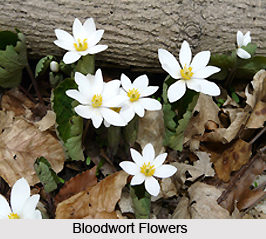 Origin and Composition
Origin and Composition
Bloodwort is an upright herb, 30 to 60 cm in height, with delicate, soft, hair. It has leafy, ridged stems and alternate, quadrilateral sharpening leaves, 5 to 10 cm in length. Its flowers are petite and swarmed with thin scales. The fruits are flat, quadrilateral shaped and glossy. The herb contains essential oil, lactones, flavonoids, tannins, coumarins, saponins, sterols, an acrid glyco alkaloid, cyanidin, aminoacids and acid sugars.
Methods of usage
Bloodwort comes of vital use in severe cases of haemorrhages, high blood pressure, abdominal upsets, piles, gynaecological troubles, or fever.
Healing Power and Medicinal Properties of bloodwort
Bloodwort is acrid, odorous, stimulant and revitalising. It is useful in controlling blood loss. It stimulates ample perspiration.
Fevers cured by bloodwort
Bloodwort is one of the best-known herbal cures for fever. A hot concoction of the herb stimulates perspiration which cools fevers and releases toxins.
High Blood Pressure healed by bloodwort
The herb is useful in curing high blood pressure. Like all sweat-inducing cures, bloodwort furthers flow to the skin which helps lower blood pressure. It is the alkaloid in bloodwort which has been reported to lower blood pressure.
Stomach Disorders cured by bloodwort
Bloodwort is a worthy remedy for several stomach disorders like colic, pyrosis and flatulence. Approximately 30 grams of its decoction may be consumed every hour in the treatment of these disorders. A dessertspoon of fresh juice of the herb, taken thrice daily, assists in digestion and gastric troubles.
Piles healed by bloodwort
As it checks blood loss, a decoction or infusion of the herb is useful in haemorrhaging piles. The powdered leaves and flower-heads are useful as carminative to ease gas when given in 6 to 30 centigram dosages.
Women`s Disorders cured by bloodwort
A hot concoction of the leaves is a dominant emmenagogue (a drug which induces menstruation) and thus useful in boosting and regularising menstrual cycles. In case of unbalanced menstrual flow, approximately 30 grams of decoction of the herb can be had each hour with favourable consequences. The volatile oil distilled from its flowers has proved advantageous in the treatment of perturbs of the female reproductive organs. Approximately 5 to 30 drops of the oil can be consumed in treating such disorders.
Wounds healed by bloodwort
Bloodwort is an efficient wound-healer. The tannins in it are possibly accountable for this attribute. It is excellent for all kinds of blood loss- both external and internal.



















